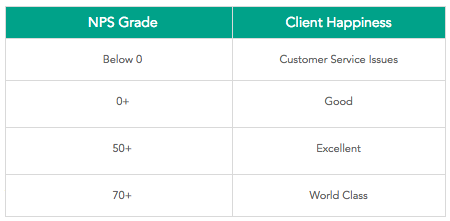
Our culture revolution. Part 8: A World-Class Net Promoter Score
We’re just a normal agency. You may own one. You may work for one. We’re ticking along nicely, picking up new business and growing at a good pace. The team size has upped from 1 to 20 in five years, with plans of reaching 50 by 2021. Everyone seems happy. But we want more.
Day Zero was the launch of our manifesto. Its aim? To revolutionise our culture, attract amazing talent, and be recognised nationally as a great place to work.
Over the course of the next few months we’ll be taking you to the heart of Reddico, sharing our highs, our lows, and our eureka moments. We’ll be honest and open about everything. What works. What doesn’t. Whether you’re here for inspiration, to watch us fail, or out of sheer curiosity, welcome along.
No hours. No managers. Rules set by the team. Let’s see what happens next.
This week we’re focusing on the NPS and why we use it as a measure for client satisfaction. As an agency we want to make a real and meaningful impact on all client campaigns (it’s one of our values after all), but we need to ensure we have a great feedback loop in place to understand happiness.
So, what is the NPS?
You may have heard of it. Perhaps you’ve completed a survey in the past without realising what it was. Maybe your business is already using NPS. Whichever is the case, we’re going to explain a little more about what it is, why we’re using it, and why we’re aiming for such a high score.
In last week’s post, we shared a video that cast some light on NPS and how it works. It’s worth having a quick watch if you want a top level overview.
[embed]https://www.youtube.com/watch?v=qWKipJefrN8[/embed]
In summary:
Send an NPS survey to your clients asking them a simple question: How likely would you be to recommend us to a friend (or colleague)?
Responses are submitted from 0-10.
Promoters (score 9-10) are loyal enthusiasts who will keep buying and refer others, fuelling growth.
Passives (score 7-8) are satisfied but unenthusiastic customers who are vulnerable to competitive offerings.
Detractors (score 0-6) are unhappy customers who can damage your brand and impede growth through negative word-of-mouth.
The final NPS score is calculated with the following formula:
% of promoters - % of detractors
So, if you have promoters (50%), passives (30%) and detractors (20%), the calculation is:
50 - 20 = 30 (your final NPS score)
NPS scores can range from -100 to +100 and are distinguished as follows:

Why we chose the NPS
2018 wasn’t the first time we used NPS to track client satisfaction. We first trialled the system in 2017, testing a few tools with varying degrees of success (the % of respondents was lower than what we hoped).
However, total scores were always in the good or excellent bracket, with us ending 2017 with a 64 (excellent).

Craig McDermott, Director of Client Services, says that the NPS system was an obvious choice when it came to finding the right client happiness tool.
He said: “We carried out a lot of research and read a lot of material to help us pin down the perfect tool, but in the end it was the Ultimate Question 2.0 that led us to this path.
“For us, it seemed the simplest way to understand the sentiment of our clients and get a great overview of exactly where relationships were most successful.”
And why the target of 75?
![]()
Craig said: “It’s in the world class bracket and that’s where we want to be – at the top of the search marketing industry.
“We have exceptionally high standards and want to make a real and meaningful impact on every project. We’re not here to tick boxes.
“As a service business we should have a much closer relationship with our clients than other industries, hence the world class target. For us it should definitely be achievable and will hopefully push the team to challenge themselves and think about how they tackle problems.
“We’re focused on building relationships and adding value in everything we do.”
To make clients more aware of the high standards we expect from ourselves and how we value their feedback, we created a separate post to explain what we use the scores and comments for internally.
Monthly client NPS meetings
If we’re using the NPS as a clear company target and will be rewarding the team for reaching a world class level, everyone needs visibility.
We created a spreadsheet with all scores and feedback and arranged all-team meetings to discuss this, identifying common themes and opportunities to improve the service we offer.
Initially we planned to send out the NPS on a monthly basis, but feedback from clients seemed to be that this was too regular. Since, we have changed this to a quarterly sendout.
How the team are rewarded
In previous years the team have enjoyed an all-expenses-paid trip away for a long weekend. This has included Budapest, Barcelona, and Zell Am Zee (skiing).
This reward was based on revenue targets, which had been met and exceeded for all three years. However, this wasn’t providing a measure of client happiness – just how many clients we had on the books.
Everyone can make an impact on client happiness and the NPS seemed a fairer way of rewarding the team for delivering great work throughout the year.
This was fed back into the team, so everyone knew the criteria and could start to plan how they’d ensure client scores hit the hallowed promoter threshold.

The future of our NPS
We plan for the NPS to be a significant part of everything we do, and to reach a point where we can customise sendouts and get 100% feedback (whether positive or constructive). To do this, we’ll need to create our own tool.
This ties in well with ongoing plans to produce our own SEO reporting suite, and including the NPS survey within this would be a great opportunity to get valuable feedback from every client we work with.
What’s next?
Next up we’re tackling a somewhat controversial subject – 360 reviews. That’s right. The team will be reviewing each other based on our core values.
And the feedback won’t be anonymous.
It sounds like a potential recipe for disaster, so come back next week to see how this is handled.
Sign-up to Reddico News
To keep up-to-date with the latest developments in the world of SEO, our insights, industry case studies and company news, sign-up here.




